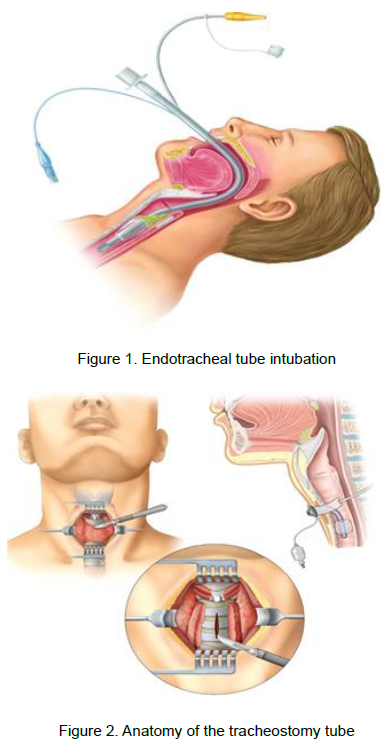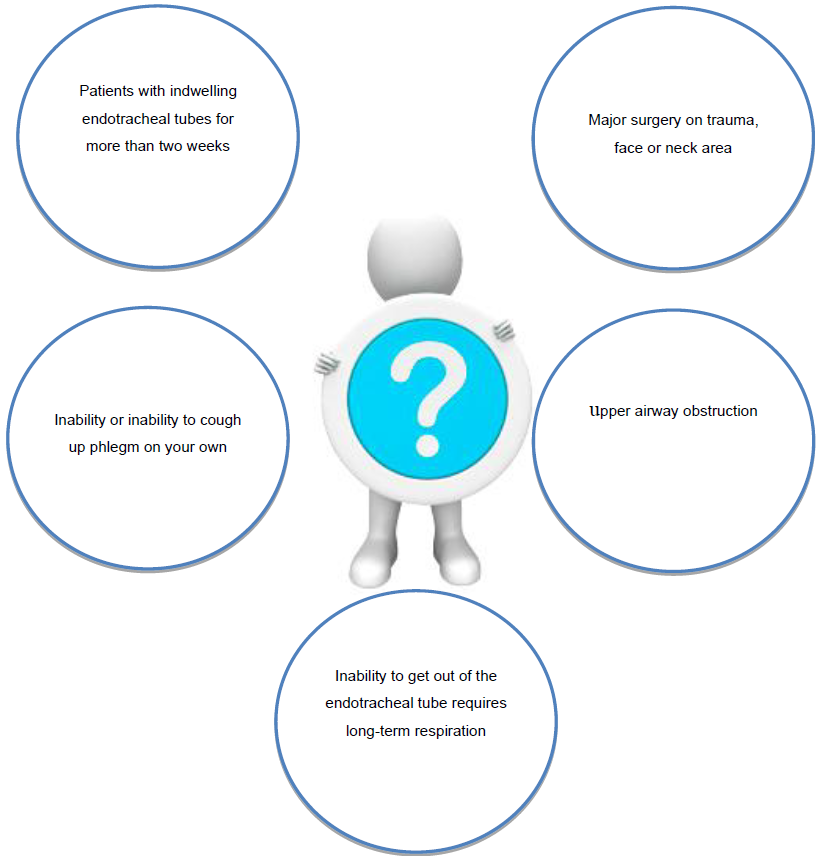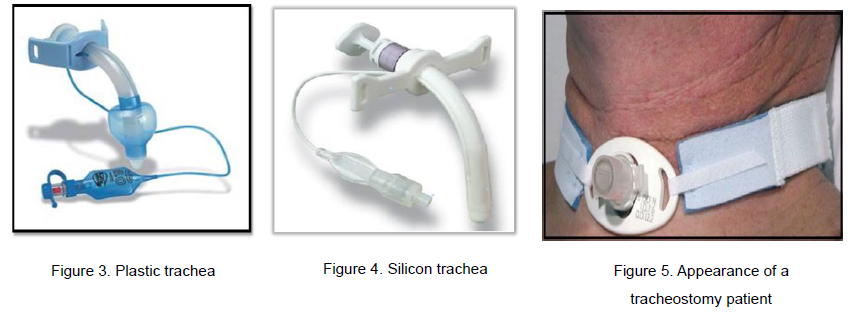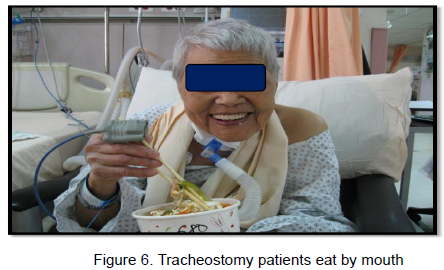【learning points】
- Tracheostomy is a surgical procedure in which an incision is made between the 2nd, 3rd or 4th cartilage under the cricoid cartilage in the neck, and a silicon tracheostomy tube is placed.
- In the long term, it is recommended to insert a tracheostomy to effectively remove respiratory secretions and facilitate the use of a respirator, and can increase patient comfort.
- The purpose of tracheostomy is to reduce the long-term placement of tubes, so as to reduce the infection rate, stabilize the condition, and still have the opportunity to leave the respirator and remove the tracheostomy cannula.
I.What is tracheotomy ?
The length of the original endotracheal tube is long (as shown in Figure 1), and long-term placement is prone to complications. In tracheotomy, a surgical incision is made between the 2nd, 3rd, or 4th canal cartilage under the cricoid cartilage of the neck, and a silicon tracheotomy tube is placed (Figure 2).

II.Which patients need tracheostomy ?

III.Reasons that shift from” endotracheal tube” to “tracheostomy tube”
Intratracheal tube placement is a medical measure for patients with acute short-term respiratory failure. If used for too long (more than 14 days), the mucous membrane at the trachea will be necrotic due to tube compression, vocal cord damage or paralysis, tracheal stenosis, aspiration pneumonia, etc.
Tracheostomy is a small operation on the neck, inserting a small tracheostomy tube (as shown in Figure 3 and Figure 4) into the trachea, which can effectively remove respiratory secretions, facilitate the use of respirator, and increase patient comfort. It is a more convenient and safe option for long-term care of family members (see Figure 5)
Tracheostomy is a small operation on the neck, inserting a small tracheostomy tube (as shown in Figure 3 and Figure 4) into the trachea, which can effectively remove respiratory secretions, facilitate the use of respirator, and increase patient comfort. It is a more convenient and safe option for long-term care of family members (see Figure 5)

IV.Preoperational preparation for tracheotomy
- he procedure of the operation is explained by the attending physician.
- Patient and family can watch tracheotomy video together.
- Visit successful case of tracheotomy patient.
- Fill consent of operation and anesthesia.
V.Complications of tracheotomy
Postoperative hemorrhage, pneumothorax, subcutaneous emphysema, tracheoesophageal fistula, vocal cord palsy, wound infection and proliferation of granulation tissue. However, these complications are uncommon.
VI.Conclusion
Tracheostomy is just another way to replace the endotracheal tube. The purpose is to reduce the long-term placement of the tube to reduce the infection rate. If the condition is stable in the future, there is still a chance to wean off the ventilator and remove the tracheostomy.
VII.Q & A
Q1: Can I talk after tracheostomy?
A1: Generally, after tracheostomy, no sound can be produced, but if the respirator can be removed in the future, the breathing and coughing function will be improved, as long as the air bag is released to let the
air flow through the vocal cords, the sound can be produced, or it can be replaced with a sound-proof device after evaluation by the doctor. Sounding tracheostomy tube.
A1: Generally, after tracheostomy, no sound can be produced, but if the respirator can be removed in the future, the breathing and coughing function will be improved, as long as the air bag is released to let the
air flow through the vocal cords, the sound can be produced, or it can be replaced with a sound-proof device after evaluation by the doctor. Sounding tracheostomy tube.
Q2: Can I eat by mouth after tracheostomy?
A2: Tracheostomy usually does not affect the swallowing function. At the beginning of the diet, the first way to eat is through a nasogastric tube. After the condition is stable, you can try to eat by mouth with
the doctor's consent (Figure 6).

VIII.References
- Ko, P. F., Chen, Y. H., Huang, H. M., Liu, T. Y., Chan, M. C., & Huang, Y. H.(2019). Improving the Awareness Rate of Tracheostomy in Family of Ventilator-Dependent Patients in the Intensive Care Unit. Clarifyin the Journal of Healthcare Management,15(3), 64-73.
簡易測驗
Let's take the questions to make sure you understand.
評語
統計結果不開放
請登入後才可以評分
未登入或權限不足!
- 位置
-
- 資料夾名稱
- English
- 上傳者
- 楊欣宜
- 單位
- 中榮護理衛教
- 英文名稱
- Introduction of tracheostomy surgery for neurological patient
- 分類
- 疾病
- 科別
- 英語
- 癌症照護
- 否
- 建立
- 2024-01-25 12:38:57
- 制訂日期
- 2016-07-25
- 最近修訂
- 2024-03-19 11:52:00